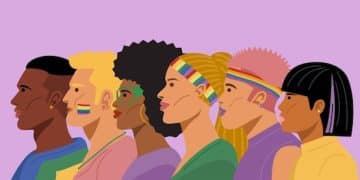Promoting Inclusive Language: A Guide for Daily Communication

Promoting inclusive language and communication in our daily lives involves actively choosing words and phrases that respect and value all individuals, regardless of their background, identity, or ability, fostering a more equitable and understanding society.
In an increasingly interconnected world, the importance of fostering understanding and respect among individuals from diverse backgrounds cannot be overstated. A key component of this effort lies in **how can we promote inclusive language and communication in our daily lives**, ensuring that our words build bridges rather than walls.
Understanding the Foundation of Inclusive Language
Inclusive language seeks to avoid expressions that exclude, marginalize, or stereotype individuals or groups of people. It’s about being mindful of the impact our words have and choosing language that is respectful and affirming. This begins with understanding the historical and social context of the words we use.
By recognizing the power of language, we can actively contribute to creating a more equitable and just society. Using inclusive language is more than just political correctness; it’s about treating all people with dignity and respect.
The Harmful Impact of Exclusive Language
Exclusive language can perpetuate stereotypes, reinforce biases, and contribute to a hostile environment for marginalized groups. It can damage self-esteem, limit opportunities, and hinder social progress. Understanding the specific ways language can be harmful is essential.
- Perpetuating Stereotypes: Using generalizations about a group of people based on limited or inaccurate information.
- Reinforcing Biases: Unconsciously favoring certain groups over others through language choices.
- Creating Hostile Environments: Using language that is offensive, discriminatory, or intimidating.

Key Principles of Inclusive Language
Several key principles guide the use of inclusive language. These principles are not rigid rules but rather guidelines to help us think critically about our language choices. Flexibility and a willingness to learn are essential.
- Person-First Language: Focus on the individual rather than their condition (e.g., “a person with a disability” instead of “a disabled person”).
- Using Gender-Neutral Language: Avoiding assumptions about gender and using terms like “they/them” when gender is unknown or irrelevant.
- Respecting Self-Identification: Honoring how people choose to identify themselves and using their preferred pronouns.
By adopting these principles, we can begin to transform our communication habits. Remember, the goal is not perfection but consistent effort and a willingness to learn and adapt.
Practical Steps to Promote Inclusive Language
Promoting inclusive language involves taking concrete steps to modify our language habits. This is an ongoing process that requires both awareness and conscious effort. It’s about identifying problematic language and replacing it with more inclusive alternatives.
These steps can be implemented in various settings, from personal conversations to professional communications. The key is to start small and gradually expand your awareness and practice.
Being Mindful of Gendered Language
Gendered language often reinforces traditional stereotypes and excludes individuals who do not identify within the gender binary. Using gender-neutral alternatives is a simple yet effective way to promote inclusivity. Consider alternative terms.
- Using “They/Them”: Utilizing these pronouns when someone’s gender is unknown or when referring to individuals who identify as non-binary.
- Replacing Gendered Terms: Substituting terms like “firefighter” for “fireman” or “chairperson” for “chairman.”
- Avoiding Gendered Assumptions: Refraining from making assumptions about someone’s gender based on their appearance or name.
Avoiding Ableist Language
Ableist language is language that devalues or stereotypes individuals with disabilities. It often uses disability-related terms negatively or insensitively. Being aware of ableist language and replacing it with respectful alternatives is crucial.
Such language can perpetuate harmful stereotypes and create barriers for people with disabilities. It’s essential to be mindful of the impact of our words and choose alternatives that promote respect and inclusion.
Using Culturally Sensitive Language
Cultural sensitivity involves being aware of and respectful toward the customs, beliefs, and values of different cultures. This includes avoiding language that may be offensive or disrespectful to cultural groups.
Cultural sensitivity extends beyond avoiding explicit stereotypes. It also involves understanding the historical context of certain terms and phrases and avoiding language that may perpetuate harmful or inaccurate representations.
The Role of Education and Awareness Programs
Education and awareness programs play a vital role in promoting inclusive language and communication. These programs can help increase understanding, challenge biases, and provide practical tools for using inclusive language.
By investing in education and awareness, organizations and communities can create a culture of inclusivity and respect. These programs can empower individuals to become advocates for inclusive language in their personal and professional lives.
Workplace Training Programs
Workplace training programs can educate employees about inclusive language and its importance. These programs can cover topics such as unconscious bias, gender-neutral language, and cultural sensitivity. They can also provide opportunities for practice and feedback.
These programs should be designed to be interactive and engaging, allowing participants to reflect on their own language habits and develop strategies for using more inclusive language. They should also be ongoing, providing regular reinforcement and updates on best practices.

Community Workshops and Seminars
Community workshops and seminars can raise awareness about inclusive language and promote dialogue among community members. These events can provide a safe and supportive space for individuals to learn, share experiences, and develop strategies for promoting inclusivity.
Such workshops can be organized by community organizations, schools, or local governments. They should be accessible to all community members, regardless of their background or knowledge level.
Challenging Implicit Biases in Communication
Implicit biases are unconscious attitudes or stereotypes that can influence our perceptions, decisions, and behaviors. Addressing these biases is essential for promoting inclusive language and communication. Self-awareness is key.
Implicit biases can manifest in subtle ways in our language choices, often without our conscious awareness. Recognizing and challenging these biases is a critical step toward creating more inclusive communication practices.
Identifying Personal Biases
The first step in challenging implicit biases is to become aware of your own biases. This can be done through self-reflection, taking implicit association tests, and seeking feedback from others. Understanding your biases is a continuous process.
It’s important to approach this process with humility and openness. Recognizing your biases is not about self-criticism but about growth and learning.
Strategies for Overcoming Bias
Once you’ve identified your biases, there are several strategies you can use to overcome them. These strategies involve consciously challenging your assumptions, seeking diverse perspectives, and practicing empathy. These methods can transform our communication from the ground up.
- Consciously Challenging Assumptions: Questioning your initial reactions and considering alternative interpretations.
- Seeking Diverse Perspectives: Engaging with people from different backgrounds and listening to their experiences.
- Practicing Empathy: Trying to understand the world from another person’s point of view.
The Impact of Media and Popular Culture
The media and popular culture have a significant impact on shaping societal attitudes and norms, including those related to language and communication. Critically evaluating media content is essential for promoting inclusive language.
By consuming media critically and advocating for more inclusive representation, individuals can contribute to a cultural shift that values diversity and respect.
Promoting Inclusive Representation
Advocating for more inclusive representation in media and popular culture can help normalize diverse identities and perspectives. This can involve supporting content that features marginalized groups and challenging content that perpetuates stereotypes. Promotion in media helps normalize diverse identities.
Supporting independent media outlets and creators who prioritize inclusive representation is also important. These outlets often provide a platform for voices and stories that are marginalized by mainstream media.
Challenging Stereotypes in Media
Actively challenging stereotypes and biased representations in media can help raise awareness and promote more accurate and nuanced portrayals of diverse groups. This can involve writing letters to media outlets, engaging in online discussions, and supporting campaigns that advocate for more inclusive representation.
Holding media accountable for perpetuating stereotypes is essential for creating a more equitable and just society. This requires critical thinking and a willingness to challenge dominant narratives.
Creating a Culture of Continuous Improvement
Promoting inclusive language is not a one-time fix but an ongoing process of learning, reflection, and adaptation. Creating a culture of continuous improvement is essential for sustaining progress.
This involves fostering a climate of curiosity, empathy, and willingness to learn from mistakes. It also requires creating systems and structures that support inclusive language practices.
Seeking Feedback and Learning from Mistakes
Actively seeking feedback from others, especially from those who are most impacted by your language choices, can help you identify areas for improvement. Be open to constructive criticism and view mistakes as opportunities for growth. Learning from mistakes is essential.
It’s important to approach feedback with humility and a commitment to learning. Remember, the goal is not to avoid making mistakes but to learn from them and become a more inclusive communicator.
Establishing Supportive Systems and Structures
Establishing supportive systems and structures within organizations and communities can help reinforce inclusive language practices. This can involve creating language guides, providing regular training, and establishing accountability mechanisms. Establishing support in practice fosters improvement.
These systems and structures should be designed to be user-friendly and accessible, providing ongoing support and resources for individuals who are committed to using inclusive language.
| Key Point | Brief Description |
|---|---|
| 🗣️ Mindful Language | Choose words that respect and value all individuals. |
| 🚫 Avoid Stereotypes | Challenge generalizations and harmful representations. |
| 📚 Education | Participate in training and raise awareness. |
| 👂 Listen & Learn | Seek feedback and adapt your language continuously. |
Frequently Asked Questions
▼
Inclusive language is language that is respectful and avoids excluding or marginalizing individuals or groups, regardless of their background, identity, or ability.
▼
Inclusive language promotes equality, respect, and understanding by ensuring everyone feels valued and included in conversations and communications.
▼
Use gender-neutral pronouns such as “they/them,” replace gendered terms (e.g., “firefighter” for “fireman”), and avoid making gender assumptions.
▼
Person-first language focuses on the individual rather than their condition, like saying “a person with a disability” instead of “a disabled person.”
▼
Acknowledge your mistake, apologize, and correct your language. Use it as an opportunity to learn and do better in the future, showing your commitment to inclusivity.
Conclusion
Promoting inclusive language and communication is an ongoing journey that requires commitment, self-reflection, and a willingness to learn and adapt. By adopting inclusive language practices, we can help create a more equitable, respectful, and understanding society for all.





